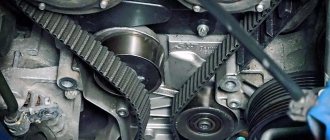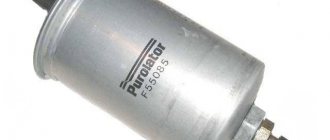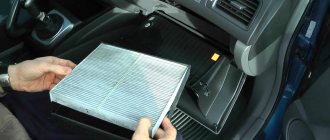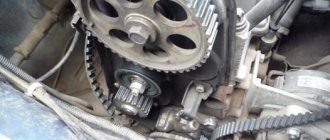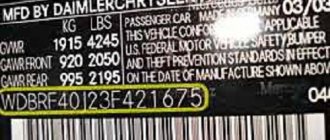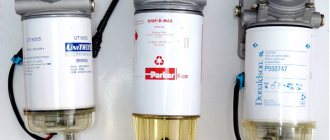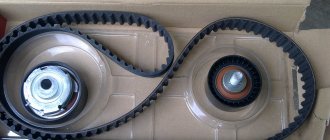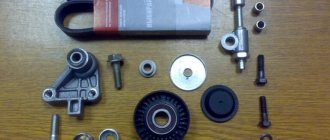Timely car maintenance is the key to safety on the road. Often the cause of an accident is the malfunction of the systems that provide movement, so the life and health of the driver, passengers, and other road users depend on the quality of car care. Consumables and components have their own service life; replacing them after a certain mileage is a mandatory procedure that the motorist can perform either personally or with the assistance of service employees. To ensure proper operation of the systems, along with oils and filters, it is also important to monitor the suitability of the belts and change them on time.
Determining when it is time to change the timing belt, unlike the alternator belt, which is easy to evaluate visually, is not so simple, especially if it is hidden under a protective casing. Replacement is carried out depending on the degree of wear, mileage of the car and design features of the engine. This element of the gas distribution mechanism, which will be discussed below, is regularly subject to loads during operation and plays a vital role in the operation of engine valves, so if you miss the deadline for replacing the part, problems will not be avoided. In some cases, a major overhaul of the motor may even be required, which is many times more expensive and more difficult than replacing the belt in a timely manner.
Service life
Without breakdowns, such a part can be used for a period of time that arises from individual factors. These include quality indicators, model features, design, etc.
You have to replace the timing belt depending on your careful and even careful attitude towards your own car. How aggressive are his rides?
- Despite the fact that the time period after which the replacement procedure must be performed is indicated by a specific manufacturer, the mileage of the car itself varies greatly.
- It ranges from sixty thousand kilometers to one hundred and twenty thousand. However, the life of the part may be longer if the owner takes good care of his car.
When the driver does not use the car constantly, over time the part loses its elastic properties as the rubber becomes obsolete.
Such operating conditions do not allow us to set an exact replacement period, since it must be changed in a timely manner. This is associated with an increased risk of drive failure and will have a negative impact on the safe driving of vehicles.
How to understand when it's time to change the belt
If it is not known at what period this element was replaced in the car, it is necessary to study how worn it is. There are signs indicating that it is time to go to a service station:
- starting the motor is accompanied by the appearance of notches on the teeth of the product;
- presence of bulges;
- the surface of the consumable is damaged;
- worn teeth;
- cracking of the product.
If the oil is leaking, the timing belt also needs to be changed.
How often do you change the timing belt?
It is worth contacting specialists at a maintenance station when the exact date of the upcoming replacement is known. Then the installation of new parts will become timely and necessary.
The positions in the technical documentation indicate not only how many years the corresponding replacement should take place, but also the mileage traveled for this. Not all cases, however, are considered the same.
It is, of course, necessary to know the manufacturer’s recommendations, but if there is a serious degree of wear, a more urgent installation of the timing belt will be required.
Moreover, the timing when, according to the manufacturer, the belt will require replacement is indicated with a considerable margin of time. When the standard mileage is slightly higher than specified, you should not always expect the belt to break.
After how many thousand km does it need to be changed?
The consumable does not have a regulated shelf life. At what mileage the timing belt is changed cannot be answered unequivocally. The lifespan of its operation is influenced by the following factors:
- temperature fluctuations in the area under the hood;
- pollution;
- contact with foreign objects;
- exposure to liquids.
Malfunction of other elements of the internal combustion engine system and high dynamic loads also affect how many kilometers the timing belt will need to be changed.
If the car has driven another 50,000 kilometers, they buy new consumables. The instructions may indicate a different period for its safe operation, but the manufacturer assumes that the car will be driven under ideal conditions.
Also, the decision to replace depends on the country in which the car was assembled. In new domestic vehicles, this element wears out after 50 thousand km, and in foreign cars - after 70 thousand km. If the car is not from the showroom, then for 30,000 and 50,000 kilometers, respectively.
In winter, drivers often warm up their car before driving off. The timing belt runs idle, the speedometer readings do not change. It is important to take this into account in order to change consumables as needed, and not at predetermined times.
Belt wears out prematurely
There are some signs that indicate that certain problems have arisen in the operation of the drive device.
From these we can conclude that the belt has reached the end of its service life:
- If there is a loss of power or there were signs of uncertainty when starting the unit. This situation is largely connected not only with the timing of replacing the belt part, but also has various reasons. If, among other things, there are malfunctions in the operation of some systems along with the ignition, then the time has come to replace the device;
- When an unpleasant rather strong odor comes out of the exhaust hole of a pipe, accompanied by a dark stream of smoke, this is regarded as an indirect sign. Not so often, but there is oversaturation of the mixture in cases of wear of the timing drive part. The problem is clarified using a scanning device using a diagnostic method;
- When the power plant is running, there are uncharacteristic sounds similar to ticking. Then replacement should be carried out immediately, since such a sign indicates tooth wear. Sliding along the pulley surface, they emit a similar whistling accompaniment. In this case, it no longer becomes particularly important how many kilometers are left before the end of the car race. Already at this moment we have to take care of updating this spare part;
- When loud sounds similar to either a squeak or a whistle occur, the liquid could well end up on the surface of the belt part. Humid weather conditions, as well as engine oil or antifreeze, contribute to this. Cleaning must be carried out in all cases, since various types of problems with the timing belt cannot be avoided in the future.
Mileage at which timing chain replacement is required
The chain has a longer service life compared to the belt. The interval from replacement to replacement depends on the design of the consumable, the engine model and the class of the car. Thus, in the budget segment there are single-row chains with a service life comparable to a belt. The need to replace them occurs after a mileage of 60-100 thousand km.
In the middle segment of cars, both single-row and double-row chains are used. The former have a resource of 150-250 thousand km. Double-row chains have an even longer life. Their replacement is required after a mileage of 200-350 thousand km.
The timing chain drive has proven itself well in Japanese cars. Replacing consumables is usually required after a mileage of 350-400 thousand km. In German cars, attention to the timing drive is not required until 400-450 thousand km.
The timing chains of premium cars have the longest lifespan. Some cars often have chains that last 500-750 thousand km without problems.
Unscheduled timing belt replacement
In some cases, deviations from the standards established for replacing the timing belt are allowed. Firstly, this concerns moments when the weakening of the belt tension is felt literally immediately after its adjustment.
Moreover, this may be due to both the deteriorated properties of the rubber and the presence of defects in the internal layers. To avoid problems in other key parts, including the engine, it is worth changing the timing belt right away.
- You can significantly reduce the possibility of a break before the expiration of the allotted period if you know exactly after what mileage it must be replaced.
- Thanks to the special level of protection in modern automobile vehicles, the group of pistons will not be immediately subject to deformation.
The great news is that the engine is still able to work, however, it is not recommended to immediately try to start the engine after a belt break occurs. The power unit may “fly”.
For such cases, the option of installing a new belt instead of the old one is provided. Using a tow vehicle, you will have to ensure the delivery of the car to the service station.
Recommendations for choosing a new timing belt
When choosing a strap, consider the following recommendations:
- Don't pay attention to cheap goods. If you use a low-quality or non-original part, engine repair will cost several times more.
- The belt must be elastic, and its surface must be smooth and without rubber deposits.
- The product number, number of teeth and length must match the old strap.
It is better to give preference to the following timing belt manufacturers: Contitech, Bosch, Dayco or Gates.
Photo instructions for replacing the timing belt
Let's sum it up
The timing belt is an important part of your car, without which the normal operation of the gas distribution system is impossible. Consequently, without a belt, the car will never drive or even start. Therefore, it is important to monitor the quality of operation of this mechanism and constantly change the belt when necessary. It is much cheaper and easier to regularly service your car than to deal with the possible consequences of a broken belt.
If the belt breaks or there are problems with the power unit, it is better to call a tow truck and transport the car to a service station. Extra movements while being towed will clearly not be beneficial for the car. All experts recommend using factory belts to ensure normal operation, but sometimes analog options can serve for quite a long period. Tell us what rules you follow for replacing the timing belt.
Determining the need to replace the timing chain
As the need to replace the chain approaches, it lengthens significantly. A consumable rupture occurs extremely rarely. This is especially true for double-row chains. You can determine the presence of an extension by measuring the consumable. It will be much longer than the new product.
Comparison of new and old chain lengths
When the chain stretches, the tensioner tries to eliminate its elongation. It can be either manual or automatic. The elongation of the chain is determined by the output of its piston.
Tensioner with chain stretched
You can check for chain stretch by pulling it on the camshaft gear. If it rises by a centimeter or more, then there is a risk of the teeth jumping and such a consumable must be replaced.
Stretched camshaft chain and gear
When the timing chain stretches, a number of external symptoms of the need for replacement appear. There is a metallic knock coming from the timing drive side. It is most noticeable on a cold engine after starting. With more severe chain wear, a timing shift occurs. The engine loses power, fuel consumption increases, and the speed becomes unstable.
Modern cars have a self-diagnosis system that receives information from sensors. A symptom of the need to replace the chain is the presence of errors in the operation of the crankshaft and camshaft sensors. You can check for problems using a diagnostic scanner.
Information about errors in the operation of the crankshaft and camshaft
To eliminate errors from the sensors themselves, it is recommended to take oscillograms of the timing belt operation. By counting them, you can see obvious symptoms of the need to replace the timing chain.
Oscillograms of timing belt operation
Factors affecting timing belt life
The frequency of replacing the timing belt and tensioner rollers is always indicated in the technical documentation of the vehicle. Every car owner should know this information and monitor the deadlines independently. But, as for any other node, this indicator is very conditional and depends on many factors. Let's sort them out.
Workmanship. Currently, timing belts are produced by several dozen companies. Manufacturers are trying to cover as large a market segment as possible. Therefore, for the same car you can find belts from several manufacturers, which will differ little visually. Unfortunately, before purchasing, you can only inspect it for accuracy of execution (smooth and well-stamped teeth without casting flaws, no protruding cord threads, equal width along the entire length of the belt).
Usually the following rule works: the more expensive the belt, the potentially higher quality, stronger and more durable it is.
Outlining through third-party equipment. How often the timing belt needs to be changed is largely influenced by this factor. If the timing belt simultaneously drives the pulleys of the pump, oil pump, distributor drive, and air conditioning compressor, its resource, despite the high quality of manufacturing, will be short.
The more pieces of equipment the timing belt drives, the greater the load placed on it.
Therefore, on cars where additional equipment has a separate drive, the timing belt resource is much longer. For example, on VAZ cars (up to Vesta and X-Ray models), the average belt life is 50–70 thousand. The reason is the large load created by additional equipment. At the same time, on many foreign cars, the timing drive, which operates only on camshafts, is capable of properly performing its functions for 120–150 thousand kilometers.
- The nature of the car's operation. A calm, measured ride has a beneficial effect on the life of the belt. Sharp rotation of the motor before cutoff will accelerate cord stretching and wear of the tooth surface.
- Security of the timing drive from the penetration of external and internal pollutants. Dust from outside and oil leaking through shaft seals can significantly reduce the life of the belt.
- Condition of gears. A good specialist will always inspect the teeth on the crankshaft and camshaft gears before replacing the timing drive. Because wear of the working surface and even single minor damage to the teeth can destroy the structure of the belt in a short period of time. By the way, on our website you can also learn how to choose a good car service center with a conscientious attitude to work based on several criteria.
Do not delay replacing the timing belt! Make an appointment with us right now by phone or using the form below. We are located at: Saransk, st. Stroitelnaya, 1, gate No. 5.
